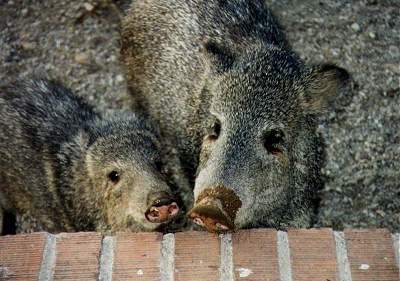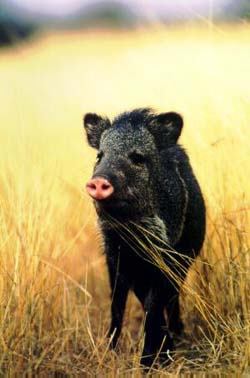

The High Country Xeriscape Council of Arizona is a non-profit 501 C-3 corporation dedicated to educating our communities about water-wise gardening. For additional information write:
HCXCA
4397 E AZ Highway 260
Payson, AZ 85541
Javelina and Electric Fences

Javelina and other wildlife can cause serious damage to garden and landscape plants. The problem of nuisance wildlife is aggravated by the increased urbanization of wildlands. The city of Prescott is a prime example of an area where increased urbanization has resulted in increased numbers of wildlife/'human conflicts, specifically conflicts between javelina and homeowners.
People move into wildlands fora number of reasons including the relaxing environment. Unfortunately, wildlife that inhabit these areas, do not understand private property rights or the value of landscaped properties. Many wild animals, such as javelina, are opportunists and will often use water and food sources wherever available, including those found in backyards.
Two common methods used to reduce wildlife damage to private property are repellents and fencing. Many types of ,repellents have been developed in attempt to keep javelina away from plants. Repellents are easy to apply and often inexpensive. However, repellents only provide limited protection against javelins because their efficiency is quickly reduced over time by weather conditions such as heat, rain, and humidity.
Fencing can provide long-term protection from nuisance wildlife. Most fencing designs create a solid barrier wildlife access. Solid barrier fences, e.g., chain link, are expensive and often not suitable for an area because of rocky substrate or homeowner covenants.
Electric fencing is a less expensive effective alternative to deter wildlife from entering gardens and other important areas around a home. Electric fences are simple to install, and they are not visually obtrusive to the landscape. These fences have been proven successful for decades on farms and ranches to control livestock and wildlife, especially deer. They have been found to control javelina especially well also.
Below are some tips to help design and build an effective electric fence. 
1. Most wild animals will touch an electrified fence only once or twice, after which they will avoid it. Therefore, be sure the fence is in complete operating condition prior to their first contact.
2. For javelina, the height of the electric fence should be adjusted to match the height of a javelina's nose. In most cases, eight to 10 inches above the ground is satisfactory. You may however need a second electric wire placed higher to prevent javelina from stepping or jumping over the first.
3. Electric fences are most efficient when animals are standing on a wet or moist surface. This helps create a better "grounding effect" for the electrical charge. During the dry season, a lawn sprinkler may be used on areas where javelina are most likely to touch the fence. The water should be applied just before periods when javelina normally appear, such as near sunset.
4. Never connect a 110-volt electrical outlet directly to the electrical fence. An electrical fence charger is necessary to convert the lethal 110-volt electrical current into a nonlethal puLsating shock.
5. Because the single stand electric wire is barely visible, plastic or cloth flagging can be hung from the fence to help prevent people from walking into it.
6. If desired, the wire can be painted to help it blend into the background. 'However, the insulating effect of the paint may reduce the fence's efficiency. Stains are less electrically insulating than a more pigmented paint. Wildlife should be allowed to have contact with the fence before it is painted.
7. An insulated electrical wire can be buried beneath the surface of the ground in areas inappropriate for above ground wires. This can help provide electric protection to several backyard garden sites while avoiding areas used by people e.g., walkways, driveways, and gates.
8. Electrical fences can be installed permanently or rolled up if desired. For example, an electric fence could be used to protect a flower bed all year, and can easily be rolled up for a flower show.
9. A photoelectric control switch can be used to automatically turn on and off the electric fence charger. These controls are useful because javelina most frequently invade garden areas during night hours. Photoelectric controls are available in most hardware stores.
The University of Arizona College of Agriculture and Life Sciences
copyright 2003© HCXCA